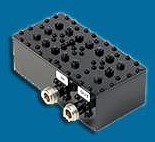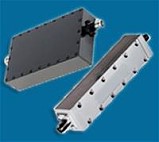|

Sam Benzacar of Anatech Electronics, an RF and microwave filter company, has published
his January 2023 newsletter that features his short op-ed entitled "Cellular to
Smartphones from Space is Coming." He writes about the rapidly evolving
direct-satellite-to-cellphone service being pioneered by AST SpaceMobile. The
photo shows their world's largest space-borne phased array
BlueWalker 3 antenna, which was lofted into orbit late last year. Using the online
Satellite
Orbital Decay Calculator to estimate the likely
orbital lifetime of the 1,500 kg (3,300 lb), 64.4 m2 (693 ft2),
BlueWalker 3 antenna array, initially in a 515 km (320 mi) high orbit,
re-entry can be expected in a little under 6 years. It probably has some amount
of propellant onboard to help maintain orbital height, thereby extending its
lifetime. No doubt the orbit height and antenna size was a tradeoff of coverage
area and path loss between the transmitter and receiver. If these LEO antenna
arrays get physically and/or numerically much larger, we may experience more
frequent solar eclipses. Maybe the companies should lobby governments for funds
based on their lowering the global temperature due to decreased sunlight. The
way governments work, though, instead they'll fine satellite companies for
lowering the efficiency of solar arrays.
A Word from Sam Benzacar - Cellular to Smartphones from Space
is Coming
 By Sam Benzacar By Sam Benzacar
As I noted in a past column in this newsletter, commercial satellite constellations
are increasing every year as the cost of fabrication and launching them into space
has become much less expensive. Nearly all the players, such as Starlink, in this
market focus on providing wireless communications virtually anywhere on Earth, and
they are using huge numbers of small spacecraft to achieve it. The number of these
small low-Earth-orbit (LEO) spacecraft should eventually add tens of thousands of
satellites to the thousands already up there.
However, the latest entrant in the market, AST SpaceMobile, located in Midland,
Texas, has chosen another approach in which "only" 168 satellites will be needed.
Its goal is to become the first global 5G broadband service that requires no modification
to existing smartphones. In contrast, Starlink requires a relatively small terminal
on a home to deliver broadband rather than directly connecting to smartphones.
To achieve this feat, AST SpaceMobile's BlueWalker 3 spacecraft requires an active
phased array antenna that measures an incredible 693 ft. (see image), which makes
it the largest commercial communications array ever deployed in LEO orbit. Like
all such antennas, it employs beam steering to optimize coverage but to serve a
broad swath of the Earth, the antennas must be enormous. The array on the BlueWalker
3 was successfully deployed to full deployment on November 10, 2022, has a field
of view greater than 300,000 square miles and sits at an altitude between (316 and
327 miles. More than 100 satellites are expected to be aloft by 2024, and AST SpaceMobile
will begin a test program across six continents with several network operators,
assuming it gets the required regulatory approvals.
 It already has agreements with mobile network operators such as Rakuten Mobile,
AT&T, Bell Canada, Telecom Argentina, Africell, Liberty Latin America, and Orange.
However, it's not the only company with similar goals, as SpaceX has inked a deal
with T-Mobile to provide the carrier's customers with text services anywhere in
the U.S. next year. Voice calls and data will presumably follow. OneWeb and Amazon
are also racing to create the technology required to achieve this, although they're
years behind SpaceX. It already has agreements with mobile network operators such as Rakuten Mobile,
AT&T, Bell Canada, Telecom Argentina, Africell, Liberty Latin America, and Orange.
However, it's not the only company with similar goals, as SpaceX has inked a deal
with T-Mobile to provide the carrier's customers with text services anywhere in
the U.S. next year. Voice calls and data will presumably follow. OneWeb and Amazon
are also racing to create the technology required to achieve this, although they're
years behind SpaceX.
While AST SpaceMobile makes a good case for delivering coverage with just a fraction
of the spacecraft of its likely competitors, it's that gigantic phased array that's
of concern to radio astronomy, which is already faced with dealing with the existing
cloud of spacecraft that can play havoc with the reception of the weak signals it
receives.
For example, astronomers at the Vera Rubin Observatory and the International
Astronomical Union are raising alarms because the antenna is large enough to reflect
so much sunlight that, at times, it can be one of the brightest objects in the night
sky. They estimate it will reach brightness magnitude 1, placing it among the 20
brightest stars, outshining more than 99% of the stars visible to the naked eye.
AST SpaceMobile is considering anti reflective materials and changes to operations
to make the satellites dimmer, and while some telescopes are designed to avoid bright
objects such as the planets or the moon, the next generation of the company's spacecraft,
called BlueBirds that are even larger than the BlueWalker 3 will be more difficult
to escape. A bright satellite passing through a digital camera's long exposure could
fry the camera's sensitive electronics.
FCC Settles the 5G vs. Altimeter Dispute
 The FAA has reinforced its ruling that many passenger and cargo aircraft must
either get new altimeters or install filters on those already in service to eliminate
risks posed by C-band 5G networks and do so before February 2024. In addition, flight
manuals must be revised to prohibit low-visibility landings after June of this year
unless either one of the actions has been taken. The FAA estimates that 7,993 aircraft
will need flight manual revisions, 180 aircraft will require complete altimeter
replacement, and 820 aircraft additional require a better C-band filter. The use
of the newly allocated C-band frequencies has resulted in a contentious battle between
the airline industry and wireless carriers. The former claimed the proximity of
the new frequencies to those used by radar altimeters could cause interference during
landing, while the wireless industry denied this was an issue. The FAA has reinforced its ruling that many passenger and cargo aircraft must
either get new altimeters or install filters on those already in service to eliminate
risks posed by C-band 5G networks and do so before February 2024. In addition, flight
manuals must be revised to prohibit low-visibility landings after June of this year
unless either one of the actions has been taken. The FAA estimates that 7,993 aircraft
will need flight manual revisions, 180 aircraft will require complete altimeter
replacement, and 820 aircraft additional require a better C-band filter. The use
of the newly allocated C-band frequencies has resulted in a contentious battle between
the airline industry and wireless carriers. The former claimed the proximity of
the new frequencies to those used by radar altimeters could cause interference during
landing, while the wireless industry denied this was an issue.
Taiwan PAVE PAWS to Get Major Upgrade
 Raytheon AN/FPS-115 PAVE PAWS long-range radar system atop Le Shan Mountain in
Taiwan will be upgraded to enhance its ability to warn the country of attacks from
mainland China and to monitor North Korean ballistic missile tests. The $412.6 million
contract to Raytheon Missiles & Defense includes logistics and engineering services,
technical updates, spare parts, and other support under the Taiwan Surveillance
Radar Program. PAVE PAWs were first deployed in various places during the 1970s
to detect and track incoming missiles, but the installation in Taiwan apparently
used outdated technology that will be replaced. It can provide more than 6 minutes
of warning time and can detect threats at distances up to 3,100 miles away. Raytheon AN/FPS-115 PAVE PAWS long-range radar system atop Le Shan Mountain in
Taiwan will be upgraded to enhance its ability to warn the country of attacks from
mainland China and to monitor North Korean ballistic missile tests. The $412.6 million
contract to Raytheon Missiles & Defense includes logistics and engineering services,
technical updates, spare parts, and other support under the Taiwan Surveillance
Radar Program. PAVE PAWs were first deployed in various places during the 1970s
to detect and track incoming missiles, but the installation in Taiwan apparently
used outdated technology that will be replaced. It can provide more than 6 minutes
of warning time and can detect threats at distances up to 3,100 miles away.
Tesla Wants to Add a Better Radar to Its Vehicles
 Tesla has filed an application with the FCC to
"re-add" a radar to their vehicles
after previously removing the earlier one, claiming that only vision systems were
required for semi-autonomous driving. The new version will be an imaging radar that
is much more capable than its predecessor that makes a low-resolution image of the
radar targets ahead of the vehicle. The company has long taken issues with the proliferation
of sensors whose data must be fused, which is a challenging task requiring considerable
processing and AI. To make its point, the company even eliminated cheap ultrasonic
sensors used when backing up a vehicle. Tesla has filed an application with the FCC to
"re-add" a radar to their vehicles
after previously removing the earlier one, claiming that only vision systems were
required for semi-autonomous driving. The new version will be an imaging radar that
is much more capable than its predecessor that makes a low-resolution image of the
radar targets ahead of the vehicle. The company has long taken issues with the proliferation
of sensors whose data must be fused, which is a challenging task requiring considerable
processing and AI. To make its point, the company even eliminated cheap ultrasonic
sensors used when backing up a vehicle.
Vulnerability Found in VoLTE
 Researchers with the Beijing University of Posts and Telecommunications and the
University of Birmingham have devised a telecom network attack that can expose call
metadata during VoLTE (Voice over LTE) conversations. It includes access to encrypted
call metadata such as call times, duration, and direction for mobile network conversations.
VoLTE encrypts voice data sent between phone and network using a stream cipher and
it has been shown to be vulnerable to something called a "reused key attack". In
their paper "Watching your call: Breaking VoLTE Privacy in LTE/5G Networks," the
researchers describe how they were able to use the metadata to map phone numbers
without detection They reported that they could map VoLTE metadata from 83.7% to
100% of the time. Researchers with the Beijing University of Posts and Telecommunications and the
University of Birmingham have devised a telecom network attack that can expose call
metadata during VoLTE (Voice over LTE) conversations. It includes access to encrypted
call metadata such as call times, duration, and direction for mobile network conversations.
VoLTE encrypts voice data sent between phone and network using a stream cipher and
it has been shown to be vulnerable to something called a "reused key attack". In
their paper "Watching your call: Breaking VoLTE Privacy in LTE/5G Networks," the
researchers describe how they were able to use the metadata to map phone numbers
without detection They reported that they could map VoLTE metadata from 83.7% to
100% of the time.
Anatech Electronics Introduces a New Line of Suspended
Stripline and Waveguide Type RF Filters
Check out Our Filter Products



Cavity Band Pass Filters
LC Band Pass Filters Cavity Bandstop/Notch Filter
About Anatech Electronics
Anatech Electronics, Inc. (AEI) specializes in the design and manufacture of
standard and custom RF and microwave filters and other passive components and subsystems
employed in commercial, industrial, and aerospace and applications. Products are
available from an operating frequency range of 10 kHz to 30 GHz and include cavity,
ceramic, crystal, LC, and surface acoustic wave (SAW), as well as power combiners/dividers,
duplexers and diplexers, directional couplers, terminations, attenuators, circulators,
EMI filters, and lightning arrestors. The company's custom products and capabilities
are available at www.anatechelectronics.com.
Contact:
Anatech Electronics, Inc.
70 Outwater Lane
Garfield, NJ 07026
(973)
772-4242
sales@anatechelectronics.com
Posted December 22, 2022
|





























 By Sam Benzacar
By Sam Benzacar
 The FAA has reinforced its ruling that many passenger and cargo aircraft must
either get new altimeters or install filters on those already in service to eliminate
risks posed by C-band 5G networks and do so before February 2024. In addition, flight
manuals must be revised to prohibit low-visibility landings after June of this year
unless either one of the actions has been taken. The FAA estimates that 7,993 aircraft
will need flight manual revisions, 180 aircraft will require complete altimeter
replacement, and 820 aircraft additional require a better C-band filter. The use
of the newly allocated C-band frequencies has resulted in a contentious battle between
the airline industry and wireless carriers. The former claimed the proximity of
the new frequencies to those used by radar altimeters could cause interference during
landing, while the wireless industry denied this was an issue.
The FAA has reinforced its ruling that many passenger and cargo aircraft must
either get new altimeters or install filters on those already in service to eliminate
risks posed by C-band 5G networks and do so before February 2024. In addition, flight
manuals must be revised to prohibit low-visibility landings after June of this year
unless either one of the actions has been taken. The FAA estimates that 7,993 aircraft
will need flight manual revisions, 180 aircraft will require complete altimeter
replacement, and 820 aircraft additional require a better C-band filter. The use
of the newly allocated C-band frequencies has resulted in a contentious battle between
the airline industry and wireless carriers. The former claimed the proximity of
the new frequencies to those used by radar altimeters could cause interference during
landing, while the wireless industry denied this was an issue.  Raytheon AN/FPS-115 PAVE PAWS long-range radar system atop Le Shan Mountain in
Taiwan will be upgraded to enhance its ability to warn the country of attacks from
mainland China and to monitor North Korean ballistic missile tests. The $412.6 million
contract to Raytheon Missiles & Defense includes logistics and engineering services,
technical updates, spare parts, and other support under the Taiwan Surveillance
Radar Program. PAVE PAWs were first deployed in various places during the 1970s
to detect and track incoming missiles, but the installation in Taiwan apparently
used outdated technology that will be replaced. It can provide more than 6 minutes
of warning time and can detect threats at distances up to 3,100 miles away.
Raytheon AN/FPS-115 PAVE PAWS long-range radar system atop Le Shan Mountain in
Taiwan will be upgraded to enhance its ability to warn the country of attacks from
mainland China and to monitor North Korean ballistic missile tests. The $412.6 million
contract to Raytheon Missiles & Defense includes logistics and engineering services,
technical updates, spare parts, and other support under the Taiwan Surveillance
Radar Program. PAVE PAWs were first deployed in various places during the 1970s
to detect and track incoming missiles, but the installation in Taiwan apparently
used outdated technology that will be replaced. It can provide more than 6 minutes
of warning time and can detect threats at distances up to 3,100 miles away.  Tesla has filed an application with the FCC to
"re-add" a radar to their vehicles
after previously removing the earlier one, claiming that only vision systems were
required for semi-autonomous driving. The new version will be an imaging radar that
is much more capable than its predecessor that makes a low-resolution image of the
radar targets ahead of the vehicle. The company has long taken issues with the proliferation
of sensors whose data must be fused, which is a challenging task requiring considerable
processing and AI. To make its point, the company even eliminated cheap ultrasonic
sensors used when backing up a vehicle.
Tesla has filed an application with the FCC to
"re-add" a radar to their vehicles
after previously removing the earlier one, claiming that only vision systems were
required for semi-autonomous driving. The new version will be an imaging radar that
is much more capable than its predecessor that makes a low-resolution image of the
radar targets ahead of the vehicle. The company has long taken issues with the proliferation
of sensors whose data must be fused, which is a challenging task requiring considerable
processing and AI. To make its point, the company even eliminated cheap ultrasonic
sensors used when backing up a vehicle.  Researchers with the Beijing University of Posts and Telecommunications and the
University of Birmingham have devised a telecom network attack that can expose call
metadata during VoLTE (Voice over LTE) conversations. It includes access to encrypted
call metadata such as call times, duration, and direction for mobile network conversations.
VoLTE encrypts voice data sent between phone and network using a stream cipher and
it has been shown to be vulnerable to something called a "reused key attack". In
their paper "Watching your call: Breaking VoLTE Privacy in LTE/5G Networks," the
researchers describe how they were able to use the metadata to map phone numbers
without detection They reported that they could map VoLTE metadata from 83.7% to
100% of the time.
Researchers with the Beijing University of Posts and Telecommunications and the
University of Birmingham have devised a telecom network attack that can expose call
metadata during VoLTE (Voice over LTE) conversations. It includes access to encrypted
call metadata such as call times, duration, and direction for mobile network conversations.
VoLTE encrypts voice data sent between phone and network using a stream cipher and
it has been shown to be vulnerable to something called a "reused key attack". In
their paper "Watching your call: Breaking VoLTE Privacy in LTE/5G Networks," the
researchers describe how they were able to use the metadata to map phone numbers
without detection They reported that they could map VoLTE metadata from 83.7% to
100% of the time. 




